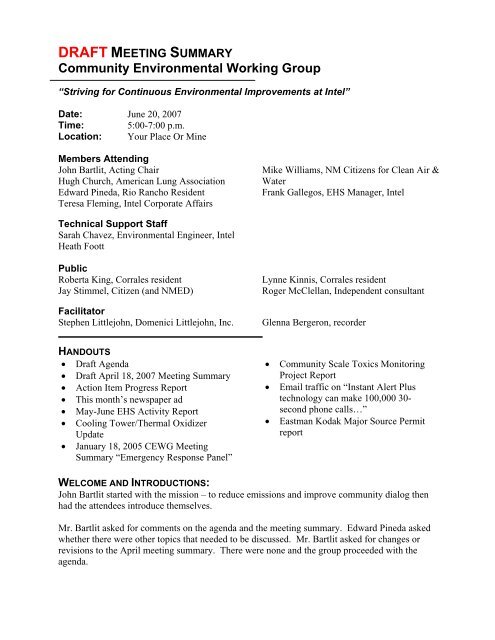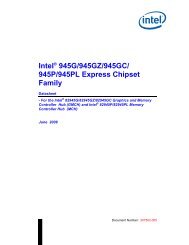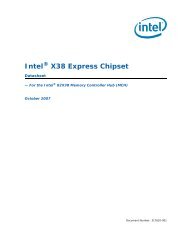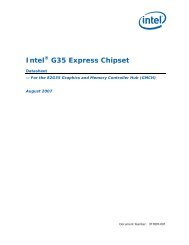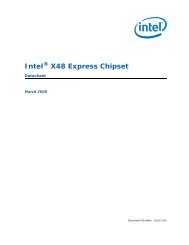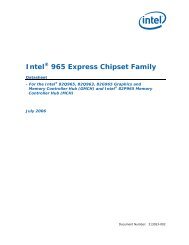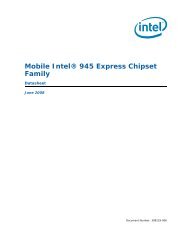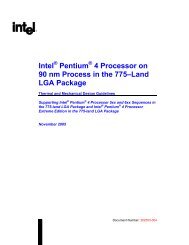Community Environmental Working Group
Community Environmental Working Group
Community Environmental Working Group
Create successful ePaper yourself
Turn your PDF publications into a flip-book with our unique Google optimized e-Paper software.
DRAFT MEETING SUMMARY<br />
<strong>Community</strong> <strong>Environmental</strong> <strong>Working</strong> <strong>Group</strong><br />
“Striving for Continuous <strong>Environmental</strong> Improvements at Intel”<br />
Date: June 20, 2007<br />
Time: 5:00-7:00 p.m.<br />
Location: Your Place Or Mine<br />
Members Attending<br />
John Bartlit, Acting Chair<br />
Hugh Church, American Lung Association<br />
Edward Pineda, Rio Rancho Resident<br />
Teresa Fleming, Intel Corporate Affairs<br />
Technical Support Staff<br />
Sarah Chavez, <strong>Environmental</strong> Engineer, Intel<br />
Heath Foott<br />
Public<br />
Roberta King, Corrales resident<br />
Jay Stimmel, Citizen (and NMED)<br />
Mike Williams, NM Citizens for Clean Air &<br />
Water<br />
Frank Gallegos, EHS Manager, Intel<br />
Lynne Kinnis, Corrales resident<br />
Roger McClellan, Independent consultant<br />
Facilitator<br />
Stephen Littlejohn, Domenici Littlejohn, Inc. Glenna Bergeron, recorder<br />
HANDOUTS<br />
• Draft Agenda<br />
• Draft April 18, 2007 Meeting Summary<br />
• Action Item Progress Report<br />
• This month’s newspaper ad<br />
• May-June EHS Activity Report<br />
• Cooling Tower/Thermal Oxidizer<br />
Update<br />
• January 18, 2005 CEWG Meeting<br />
Summary “Emergency Response Panel”<br />
• <strong>Community</strong> Scale Toxics Monitoring<br />
Project Report<br />
• Email traffic on “Instant Alert Plus<br />
technology can make 100,000 30second<br />
phone calls…”<br />
• Eastman Kodak Major Source Permit<br />
report<br />
WELCOME AND INTRODUCTIONS:<br />
John Bartlit started with the mission – to reduce emissions and improve community dialog then<br />
had the attendees introduce themselves.<br />
Mr. Bartlit asked for comments on the agenda and the meeting summary. Edward Pineda asked<br />
whether there were other topics that needed to be discussed. Mr. Bartlit asked for changes or<br />
revisions to the April meeting summary. There were none and the group proceeded with the<br />
agenda.
COMMUNITY SCALE TOXIC MONITORING PROJECT<br />
Hugh Church provided an introduction to the project as well as a handout. The project was<br />
presented at the Air and Waste Management Association, Albuquerque Chapter meeting in April<br />
of this year by Therese Martinez-Loner from the City of Albuquerque’s Air Quality Division.<br />
The project is being funded by EPA Headquarters to monitor and assess Bernalillo County<br />
hydrocarbon emissions. One monitoring site is only two miles from here and may capture Intel<br />
emissions that are of concern by the group.<br />
• Mr. Bartlit asked how much funding the EPA provided. No one who attended the<br />
luncheon could remember the exact amount. But Mr. Bartlit believed it was on the order<br />
of $20 to $30 thousand. Mr. Church concurred.<br />
• Mr. Bartlit stated that the project is not directly related to what the CEWG is doing, but<br />
with a monitoring site in such close proximity, it could provide useful data.<br />
• Mr. Pineda asked how the project could help the CEWG. He suggested that we get the<br />
“recipe” for getting the grant money. What are the key points to make in a grant<br />
application? Would the EPA accept the use of the CEWG’s Citizen Protocol testing<br />
methods?<br />
• Mr. Church pointed out that there were many of these type projects going on around the<br />
country. Mr. Bartlit added that it was municipality air quality bureaus that were getting<br />
the funding, not citizen’s groups.<br />
CITIZEN PROTOCOL<br />
Stephen Littlejohn discussed actions taken in the past two months on the Citizen Protocol,<br />
including an on-line deliberative process to determine next steps. There was consensus that the<br />
group needed to get legal advice to evaluate the protocol from a legal perspective. The best way<br />
to proceed in the development and implementation of the protocol was to develop a pilot project<br />
based on previous discussions and community concerns. The CEWG should decide on the pilot<br />
project and use it as a basis to get both legal advice and funding.<br />
Funding appears to be the most significant issue associated with the protocol. There has been<br />
progress made in that regard. The U.S. Institute for <strong>Environmental</strong> Conflict Resolution may be<br />
able to help. Their website is www.ecr.gov. The agency is located in Tucson AZ.<br />
Once the CEWG puts together a proposal for the pilot project, the group could submit it to the<br />
Institute for potential funding.<br />
1. Mr. Bartlit added that the group had potential for both funding and providing technical<br />
expertise.<br />
2. Mr. Pineda asked whether the Institute was a government agency (given the fact that they<br />
have a .gov URL). Could someone from the group approach them to see if they would be<br />
willing to review the Citizen Protocol? Mr. Littlejohn said that he intended to do that and<br />
talk to the Institute about funding as well as the possibility of a legal review. Mr. Bartlit<br />
agreed that asking for a legal review was a good idea.<br />
3. Mr. Pineda suggested that the CEWG ask the community what it would like to see as the<br />
pilot project. Mr. Littlejohn agreed and suggested that a list of topics be sent to everyone<br />
on the distribution list to gather input from the community on proposed pilot project<br />
topics. The objective would be for the CEWG to select a pilot project topic at the July<br />
meeting.<br />
<strong>Community</strong> <strong>Environmental</strong> <strong>Working</strong> <strong>Group</strong> Meeting Summary June 20, 2007 2
4. Mr. Bartlit asked whether Mary Uhl, Chief of the Air Quality Bureau, had ever provided<br />
a review of the Protocol? Mr. Littlejohn responded that she had given the request to both<br />
the Air Quality Bureau and the Water Quality Bureau. The Water Quality Bureau had<br />
provided a response, the Air Quality Bureau had not.<br />
5. Mr. Littlejohn said that he had sent a couple of friendly reminders to the Air Quality<br />
Bureau, but had not received a response. He said since some time had passed, he would<br />
send them another reminder.<br />
6. Mr. Littlejohn summarized the progress on the Citizen Protocol. The Protocol<br />
subcommittee has completed its tasks very well and it is time to proceed with an actual<br />
project. Mr. Pineda raised a concern about liability associated with the protocol and Mr.<br />
Bartlit asked about enforcement or monitoring of the protocol procedures.<br />
7. Roger McClellan pointed out that at some point the CEWG is going to have to address<br />
the issue of what legal entity is going to be responsible for actions taken under the Citizen<br />
Protocol? Who will receive the grant monies, expend the grant monies, etc.?<br />
Government agencies are not going to fund any activity without there being a<br />
corporation, or some kind of legal entity that can be held accountable. Mr. Bartlit<br />
responded that the Institute for <strong>Environmental</strong> Conflict Resolution dealt with issues<br />
between “government type things and public type things” and must have some way of<br />
dealing with the issue.<br />
8. Mr. Pineda agreed with Mr. McClellan that some kind of legal standing was necessary.<br />
ACTION ITEMS FROM THE DISCUSSION:<br />
1. Jay Stimmel will carry the message back to the Air Quality Bureau asking for a<br />
response.<br />
2. Stephen Littlejohn will initiate a community email discussion to identify possible<br />
topics for a CP pilot project.<br />
3. Once a CP pilot project is identified, Stephen Littlejohn will approach the<br />
Institute for <strong>Environmental</strong> Conflict Resolution about a possible legal review<br />
and possible funding for the pilot.<br />
PUBLIC COMMENT<br />
• Lynne Kinnis raised a concern about the newspaper ad. She requested that a list of<br />
subjects to be discussed during the announced meeting be added to the advertisement, so<br />
that people could decide whether they wanted to attend based on the topics to be<br />
discussed.<br />
• Ms Kinnis also raised a concern about new processes at Intel that include the use of “a<br />
secret sauce”. She requested the CEWG ask NMED for an evaluation of the toxicity of<br />
any chemicals or materials that would be a part of the “secret sauce”.<br />
• Mr. Pineda stated that the permit requires that any new chemicals used in the process be<br />
reported to NMED, as well as the quantities used, where will they be used in the process,<br />
and the likely emissions.<br />
• Frank Gallegos agreed that all the information is provided to NMED, but that the process<br />
is proprietary and will necessarily be protected. The Intel emissions should be reduced as<br />
a result of changing to the new process.<br />
<strong>Community</strong> <strong>Environmental</strong> <strong>Working</strong> <strong>Group</strong> Meeting Summary June 20, 2007 3
• Mr. Pineda requested that Intel provide a presentation at the next meeting on new<br />
processes and new chemicals being used.<br />
• Teresa Fleming pointed out that the process has not been finalized.<br />
• Ms Kinnis asked whether NMED had ever evaluated VOC emissions during downtimes<br />
or during plant upsets as opposed to normal plant operations. She also asked why the<br />
downtimes and upsets continue to happen. She said she didn’t expect an answer tonight,<br />
but she was curious.<br />
• Mr. Pineda asked how frequently Intel measures the removal efficiency of the RTOs and<br />
scrubbers. Frank Gallegos responded that Intel’s third party consultants routinely do<br />
emissions test where they do input and output sampling that provides removal efficiency.<br />
They also do effluent sampling of the stacks that would point out any discrepancies. The<br />
consultants are out in the plant for most of the year. Mr. Pineda suggested that every<br />
scrubber and RTO be tested every year.<br />
ACTION ITEM FROM THE DISCUSSION: Mr. Gallegos agreed to put together a<br />
presentation as soon as possible to discuss the new process and its impact on emissions.<br />
EASTMAN KODAK MAJOR SOURCE PERMIT<br />
Mr. Bartlit explained that Intel’s minor source permit versus major source permit has been a<br />
topic of discussion for some time. The Eastman Kodak plant in Rochester NY is the only chip<br />
manufacturer in the country operating under a major source permit. Sarah Chavez provided a<br />
presentation on the EK major source permit. (Report attached; see also EK permit site at<br />
http://www.kodak.com/US/plugins/acrobat/en/corp/HSE/KPHSE_2005.pdf.)<br />
• The presentation explains what kind of facilities Eastman Kodak has, what their<br />
semiconductor facility permit requirements are, and what the requirements are for the rest<br />
of their facilities.<br />
• The Eastman Kodak facility is over 1,100 acres with 22 miles of fence line, 125<br />
manufacturing buildings, 30 miles of roads, two power plants, and their own sewer and<br />
wastewater treatment facility. It is a very large facility. The local Intel site is 300 acres<br />
by comparison.<br />
• Air emissions are 2.9 million pounds per year. Intel’s emissions were around 28,000<br />
pounds last year.<br />
• Power plant emissions (SO2, CO, NOx, particulates, VOCs) were 58.9 million pounds in<br />
2004.<br />
• There are two permits and two permit review reports – over 1400 pages.<br />
• There are 55 emission units listed in the permits. Intel by comparison would have one<br />
emission unit at the local plant.<br />
• They appear to have the entire federal HAPs list with most emission levels greater than<br />
10 tons per year. Their criteria pollutants (CO, NOx, SO2) each have a potential emission<br />
rate of greater than 250 tons per year.<br />
• There are 10 emission points for the semiconductor facility (equivalent to Intel’s stacks)<br />
and three processes. They have 35,000 ft 2 of clean room space as compared to over a<br />
<strong>Community</strong> <strong>Environmental</strong> <strong>Working</strong> <strong>Group</strong> Meeting Summary June 20, 2007 4
million for Intel. They are not a major high volume semiconductor manufacturing<br />
facility.<br />
• Their facility was built in the 1970s.<br />
• They are subject to maximum achievable control technology (MACT) because the entire<br />
facility is a major source. Their emissions from their semiconductor facility is a very<br />
small part of their total emissions.<br />
• They have no abatement equipment on their semiconductor facility. Mr. Pineda asked<br />
how that was possible. Mr. Gallegos said that is part of having a major source permit,<br />
they are allowed to emit larger quantities of emissions. Mr. Pineda asked if they had<br />
neighbors. Ms Chavez responded that there are 13,000 households, roughly 50,000<br />
people living and working in close proximity to the plant.<br />
• They are able to remain below the MACT thresholds of 20 ppmv for organics and 0.42<br />
ppmv for inorganics at the stack. Mr. Bartlit asked what Intel’s stack numbers were. Ms<br />
Chavez responded that without controls, Intel’s stacks were 30 ppmv and with controls<br />
they were 1-2 ppmv.<br />
• There are no testing requirements under the permit. They demonstrate compliance using<br />
engineering assessments, other monitoring (temperatures, pressures, etc.), and emissions<br />
calculations.<br />
• They are subject to NY state reasonable available control technology (RACT) for cold<br />
cleaning degreasers which limits annual VOC emissions on a rolling 12 month basis.<br />
RACT requires specific emission calculations, semiannual reporting, and some specific<br />
operational requirements.<br />
• Mr. Pineda asked whether the plant really ran on prayer and a hope. There are no testing,<br />
no monitoring, no risk assessments? Do they have many community complaints? Ms<br />
Chavez responded that they have a very active community group that uses engineering<br />
calculations and other forms of monitoring that does not include testing. They<br />
demonstrate compliance by monitoring temperatures and maintenance records. That<br />
would show the regulating agency that the plant is being operated within the regulatory<br />
limits. These methods are routinely accepted by regulatory agencies.<br />
• Mr. Bartlit asked whether there were any emissions limitations shorter than one year.<br />
Ms Chavez responded no.<br />
• Mr. Pineda asked how they dealt with spikes in emissions. Ms Chavez said she had not<br />
asked that question. Mr. Gallegos pointed out that there was no monitoring or abatement<br />
equipment, so there would be no way to identify or control any spikes. Ms Chavez<br />
reiterated that the semiconductor plant was very small when compared to the rest of the<br />
facility and that the major source permit was for the entire facility.<br />
• Mr. Bartlit asked whether the chemicals used in the semiconductor plant were the same<br />
as what Intel uses. Ms Chavez responded that she had not received that much detail in<br />
the reports that she had read. The reports only had to state whether they had complied<br />
with the operations permits. It did not provide details on how much of each chemical they<br />
had released.<br />
<strong>Community</strong> <strong>Environmental</strong> <strong>Working</strong> <strong>Group</strong> Meeting Summary June 20, 2007 5
• Mr. McClellan discussed that the primary function of the plant was to produce<br />
photographic materials, film, etc., and that production used a very wide range of<br />
chemicals. The major source permit was centered around that production. He was<br />
familiar with the facility. It is a huge a complex.<br />
• Mr. Pineda asked whether there was a specific part of the permit that dealt with the<br />
semiconductor plant. Ms Chavez said no, the permit covered the facility as a whole and<br />
it had a huge list of chemicals that they were permitted to emit. Mr. Pineda then asked<br />
whether members of our community would like to operate under such a permit. Ms<br />
Kinnis stated that we needed to understand how their plant operated – that the<br />
semiconductor plant was very small when compared to the Intel facility here.<br />
• Ms Chavez then discussed the requirements for the rest of the plant. Control equipment<br />
is required in other parts of the plant – RTO, scrubbers, absorbers, carbon adsorption<br />
systems, etc. These systems were put in place to meet best available control technology<br />
(BACT) and RACT requirements.<br />
• Generally, there are no concentration limits at the stack and no short-term limits. There<br />
are regulatory limits on concentrations and the company is allowed to show via modeling<br />
that they are below the regulatory limits. If the modeling shows levels above the toxicity<br />
limits, then additional requirements may be levied, but in general there are no short term<br />
limits in the permit.<br />
• The only continuous emissions monitoring were for opacity on the power plant and<br />
hazardous waste incinerator stacks and to demonstrate removal efficiency for VOCs in<br />
the acetate film manufacturing area.<br />
• They have a semiannual compliance report that summarizes compliance with all<br />
conditions in permit. They also have to accomplish an annual emissions survey that is<br />
very similar to the annual survey required under the Intel permit.<br />
• The only testing requirement found in the Kodak major source permit was for<br />
intermittent testing. For example, they might have to monitor mercury for their chemical<br />
waste incinerator or to measure particulates from their polyester film-based<br />
manufacturing, but only at the request of the department. Operations and maintenance<br />
actions were also listed under the intermittent testing requirements.<br />
• There was no quarterly or annual testing required under the major source permit.<br />
• Mr. Pineda asked about wastewater testing requirements. Ms Chavez said she only<br />
inquired about the air permit. Mr. McClellan said Kodak had its own wastewater<br />
treatment plant.<br />
• Mr. Bartlit observed that the Kodak major source permit did not appear to provide any<br />
additional protections over the existing Intel minor source permit.<br />
• Roberta King said the previous Intel major source permit provided more protections than<br />
the minor source permit.<br />
• Mr. Pineda asked Mr. Stimmel whether NMED had issued any major source permits in<br />
New Mexico. If so, could he provide the number of permits and who they were issued to.<br />
Mr. Stimmel agreed to provide those for the next meeting.<br />
<strong>Community</strong> <strong>Environmental</strong> <strong>Working</strong> <strong>Group</strong> Meeting Summary June 20, 2007 6
• Ms King observed that a local woodworking shop required a major source permit because<br />
of the particulate emissions. No one has brought up particulates with respect to Intel.<br />
ACTION ITEM FROM THE DISCUSSION: Mr. Stimmel agreed to provide the<br />
number of major source permits in New Mexico.<br />
THERMAL OXIDIZER AND COOLING TOWER MAINTENANCE<br />
Mr. Gallegos provided a brief overview of the thermal oxidizer and cooling tower maintenance.<br />
(Report attached). Last year, he provided a detailed list of what the emissions were from the<br />
oxidizers and the cooling towers. He did not do that for this meeting, but if desired, he could<br />
have it for a future meeting.<br />
As a result of discussions with the community, Intel put together a task force to walk the site to<br />
identify where odors might be coming from. One of the areas identified where the cooling<br />
towers.<br />
• The cooling towers were being bulk fed biocide to kill bacteria growing in the cooling<br />
water. The towers were being fed four times per day at 7 am/pm and 1 am/pm.<br />
• Intel installed an automated system on the North cooling towers that added biocides<br />
based on the quantity of bacteria in the water. Although there were some initial<br />
problems, the system is now working and it has reduced the required biocide by 70 to 80<br />
percent.<br />
• Mr. Pineda pointed out that the north cooling towers are not the ones closest to Corrales.<br />
Mr. Gallegos said they planned to add the same system to the CUBs cooling towers. Mr.<br />
Pineda asked when the system would be installed. Mr. Gallegos believed it would be<br />
sometime this year.<br />
• Mr. Gallegos explained the chart showing biocide treatment before and after the<br />
installation of the 3D TRASAR system.<br />
• Ms Kinnis asked about the spikes in the graph. Mr. Gallegos explained that the spikes<br />
were the amount of time the biocide valve was open.<br />
• Mr. McClelland pointed out that bacterial growth could also cause odors and asked<br />
whether the new system was as effective at killing off the bacteria. Mr. Gallegos<br />
responded that the water was tested daily to check bacterial growth and it appears the<br />
system is just as effective as the bulk feeding.<br />
• Mr. Bartlit asked if Mr. Gallegos could describe the smell of the biocide. He said it<br />
smelled kind of musty, like mildew or like a swimming pool.<br />
• Mr. Pineda asked whether the task force was still walking plant looking for odors. Mr.<br />
Gallegos responded that they were. Mr. Pineda asked whether the community had<br />
noticed a change in the odors. Ms King responded that a friend of hers had been walking<br />
and smelled bromide. Mr. Gallegos said bromide was used as one of the biocides.<br />
• Next Mr. Gallegos gave an update on the thermal oxidizers. He explained how they used<br />
to perform routine maintenance on the oxidizers. They would shut the oxidizers down at<br />
midnight, the maintenance crew would come in at 7 am and work until 8 pm, then they<br />
would leave and finish the job the next day. Based on recommendations from the<br />
<strong>Community</strong> <strong>Environmental</strong> <strong>Working</strong> <strong>Group</strong> Meeting Summary June 20, 2007 7
CEWG, the maintenance crew can now complete the routine maintenance in 17-20 hours<br />
versus the 40+ hours it used to take.<br />
• For 2006, there were 467 downtime hours (scheduled and unscheduled) versus 500 hours<br />
for 2005. Downtime was reduced despite the gas and power disturbances.<br />
• The reduced PM schedule is still in effect. Current PMs take an average of 17 hours<br />
versus 40 hours.<br />
• The minimum possible downtime per year with no projects or failures is approximately<br />
136 -170 hours (four units requiring maintenance every six months).<br />
• Mr. Pineda pointed out that Intel should have parts on hand for equipment that fails. Mr.<br />
Gallegos responded that their permit required that they have two spares for critical<br />
equipment.<br />
• Mr. Pineda asked how long it took to cool down the oxidizers before work could be<br />
started. Mr. Gallegos responded that it took four hours, which was why the schedule<br />
showed them being shut down at 4 am.<br />
• Ms Fleming pointed out that all downtime is logged and records are kept and reviewed as<br />
part of the maintenance crew’s training. That helps to further reduce the downtime by<br />
using lessons learned from previous experiences.<br />
• Mr. Bartlit asked how we could evaluate the benefit of the changes to the community.<br />
The evaluation tells us something about how much it is worth to cut it further, either by<br />
efforts, ideas, or new equipment. How does it help? It reduces emissions, but is there a<br />
way to evaluate the benefit to the community. Ms Kinnis responded that the community<br />
is mainly concerned about the emissions, so reduction of raw pollution, or installation of<br />
new equipment so emissions are lower is something that the community would use as a<br />
rule of thumb.<br />
• Ms Kinnis thanked Intel for working on the streamlined maintenance procedures and the<br />
improved biocide system, but why does it take so long to make changes that have proven<br />
successful. Why don’t they install the biocide system on the other cooling towers now?<br />
Mr. Gallegos explained that it had taken time to fine tune the system and verify that it<br />
works the way it should. Then the system has to be engineered for the CUB.<br />
• Mr. Pineda asked whether there were any plans to put redundant RTOs in the system.<br />
Mr. Gallegos responded that there were no plans at this time to install redundant RTOs.<br />
There are redundant scrubbers, but not in the RTOs. An Intel engineer pointed out that<br />
redundant RTOs don’t necessarily make sense. For it to work, the backup RTO would<br />
have to be heated to operational temperatures around the clock, which would increase<br />
NOx and CO emissions. Mr. Pineda took exception to the point. If redundant equipment<br />
were in place, it would keep untreated emissions from the lungs of the community. If a<br />
cost benefit analysis was done, Intel would be a winner if they installed redundant RTOs.<br />
Mr. Pineda asked for redundant RTOs four years ago and Intel has not listened to the<br />
community! Mr. Littlejohn added redundancy to the list of future topics.<br />
• Ms Kinnis agreed with Mr. Pineda and suggested that Intel should take it upon<br />
themselves to add redundancy and improve processes instead of having to have the<br />
community apply constant pressure. Intel needs to be more proactive.<br />
<strong>Community</strong> <strong>Environmental</strong> <strong>Working</strong> <strong>Group</strong> Meeting Summary June 20, 2007 8
EMERGENCY RESPONSE<br />
Emergency response has been a priority topic for the past year. The purpose of the discussion<br />
here is to help frame the topic for future discussions. Minutes from the January 2005 meeting<br />
were provided to start the discussion.<br />
• Mr. Bartlit said he had an opportunity to talk to the new vice president for corporate<br />
affairs, Will Swope, and the Mayor of Rio Rancho about the emergency messaging<br />
system idea presented by Shari Martinez. The idea seems to have benefit for the entire<br />
community as well as Intel. There were no agreements reached, but the idea was<br />
presented. Mr. Littlejohn pointed out that an email describing the system was in the<br />
handouts.<br />
• Mr. Pineda asked that the system be put in place just for emergencies at Intel to start.<br />
After it is installed applications could be expanded.<br />
• Mr. Bartlit suggested another panel discussion. It would bring the appropriate players<br />
together and let them hear each other and help them to understand what progress has been<br />
made or what progress was lacking.<br />
• Mr. Pineda suggested the group concentrate on getting an emergency notification system<br />
in place for Intel first. Mr. McClelland pointed out that everyone needed to understand<br />
what kind of emergencies would trigger the emergency notification system. Mr.<br />
Littlejohn expanded the question: what conditions would trigger the system, what would<br />
the criteria be, how could you tell the conditions were serious enough to notify the<br />
community, etc.<br />
• Mr. Pineda said that any condition that would seriously increase the emissions should<br />
result in an emergency notification. Ms Fleming pointed out that during the last power<br />
failure there were no unabated emissions, because the entire plant went down. Mr.<br />
Pineda suggested that the CEWG establish a subgroup to identify specific criteria for<br />
when the public should be notified. The suggestion was made that case studies be<br />
reviewed to see if this has been done elsewhere. The group agreed that that was a good<br />
approach.<br />
• A discussion ensued about what kind of notification system should be used. Sirens are a<br />
possibility, but there would have to be distinctive sirens that would convey different<br />
kinds of threats and provide different actions from the community. The community<br />
would need to understand and know how to respond to any signals.<br />
• Mr. Littlejohn asked how the group felt about Mr. Pineda’s suggestion of forming a<br />
subgroup to look at the issue. Mr. Bartlit suggested that the group use an email dialog to<br />
discuss what should trigger an emergency notification system. The email dialog could<br />
also be used to find community participants for a subgroup.<br />
• Mr. Church asked whether Intel had an emergency response group. Mr. Gallegos said<br />
they did. Intel does scenario planning using all levels of management. Ms Fleming<br />
suggested that the Sandoval County Fire Department is responsible for emergency<br />
response and should participate. Mr. Pineda again tried to focus the discussion on an<br />
emergency notification system.<br />
• Mr. Littlejohn summarized the next steps in an email dialog to identify topics of<br />
discussion, establish a committee to take a look at a notification system, and secondary to<br />
<strong>Community</strong> <strong>Environmental</strong> <strong>Working</strong> <strong>Group</strong> Meeting Summary June 20, 2007 9
that, what responses might be. In addition, the group should review case studies and<br />
benchmarks as well as consider the possibility of an Intel presentation.<br />
• Mr. Pineda asked whether Intel would be willing to participate and finance an emergency<br />
notification system. Mr. Gallegos said it would depend on what system was proposed.<br />
Ms Fleming pointed out that any emergency notification system would require<br />
memoranda of understanding between all the emergency response agencies in the<br />
community.<br />
• Mr. Williams asked whether Intel had people that monitor event data and dispersion in<br />
the atmosphere. Mr. Gallegos said no.<br />
ACTION ITEM FROM THE DISCUSSION: Stephen Littlejohn will initiate an email<br />
discussion of emergency response, establish a committee to look at the subject in more<br />
detail, and begin email discussions within the committee.<br />
ADDITIONAL BUSINESS<br />
Mr. Gallegos reviewed the EHS report. There have been two inspections in the past two months. The US<br />
EPA performed a Spill Prevention, Control, and Countermeasures (SPCC) Plan Inspection. There are no<br />
adverse findings expected, based on conversations with the inspectors. The Albuquerque Bernalillo<br />
County Water Utility Authority performed a wastewater inspection on June 5 th . The agency indicated the<br />
program and treatment systems were in good condition and Intel expects no further action.<br />
• Mr Pineda asked Mr. Gallegos for the limits for lead. Mr. Gallegos agreed to provide the<br />
numbers at the next meeting. Ms King asked for all metals in the wastewater permit.<br />
• Ms King asked what chemical was used for weed control. Mr. Gallegos said that he<br />
would provide an updated list at the next meeting.<br />
NEXT MEETING<br />
• July 18, 2007, 5 PM at Your Place or Mine.<br />
Future Agenda Topics:<br />
• Annual Progress Report<br />
• Ongoing discussion of emergency response and possible panel<br />
• Citizen Protocol<br />
• Noise issues<br />
• USATSDR report on health effects<br />
• ISO 14,000<br />
• RTO redundancy<br />
• Abatement efficiency<br />
<strong>Community</strong> <strong>Environmental</strong> <strong>Working</strong> <strong>Group</strong> Meeting Summary June 20, 2007 10


